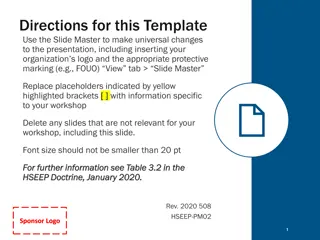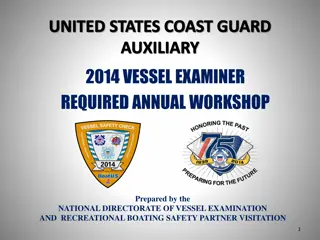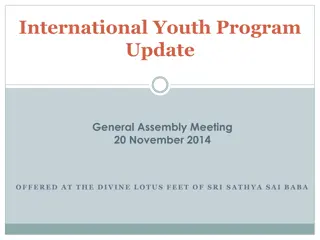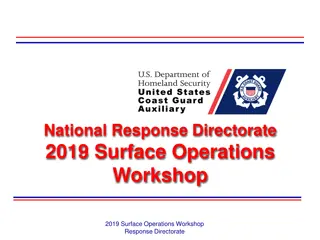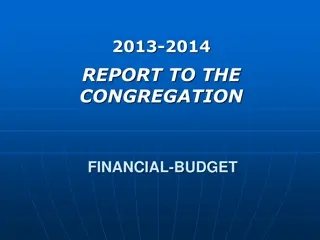
Interagency Resource Representative (IARR) - Skills and Responsibilities in Incident Management
"Learn about the role of Interagency Resource Representatives (IARR) who provide liaison services for incidents across geographic areas. Discover the skills required, coordination processes, and pre-requisite experience for effective incident management."
Download Presentation

Please find below an Image/Link to download the presentation.
The content on the website is provided AS IS for your information and personal use only. It may not be sold, licensed, or shared on other websites without obtaining consent from the author. If you encounter any issues during the download, it is possible that the publisher has removed the file from their server.
You are allowed to download the files provided on this website for personal or commercial use, subject to the condition that they are used lawfully. All files are the property of their respective owners.
The content on the website is provided AS IS for your information and personal use only. It may not be sold, licensed, or shared on other websites without obtaining consent from the author.
E N D
Presentation Transcript
Interagency Resource Representative (IARR) Nationally the Interagency Resource Representative (IARR) position utilizes a variety of skills and abilities to provide liaison services for personnel assigned to out of geographic area incidents. The IARR acts as a liaison for sending area resources and is responsible to the sending Geographic Area.
Interagency Resource Representative (IARR) The IARR will coordinate through Incident Management Teams, Geographic Area Coordination Centers, hosting Agency Administrators, Fire Management Organizations, Multi-Agency Coordinating Groups (MAC), and represents the well-being of all resources assigned from the sending Geographic Area.
The Need for an IARR IARR s are usually ordered by the sending GACC and report directly to the Coordinator on Duty or the IARR Coordinator if the position is activated. Often, trigger points are pre-established and tied to numbers of crews (4 or more crews committed to a particular location), overhead, etc. that have been assigned.
The Need for an IARR In many cases the IARR may represent a number of agencies from the home geographic area so that each agency does not need to send individual IARRs.
IARR Network GACC Incident Support Resources IARR Incident Host Unit IMT Resource Home Unit
Pre-Requisite Experience IARR s should be highly skilled in: Incident Business Management Practices, Crew Timekeeping, Medical Care Procedures Accident Investigation and Reporting, Personnel Management, Mob & Demob Procedures and Sending Geographic Area Crew Management Guidelines.
Pre-Requisite Experience IARR s should have in-depth knowledge of: Agency Policy and Procedures, Fire Operations, Agreements, (general knowledge) The Incident Command System (ICS), and The Dispatch/Coordination System.
Pre-Requisite Experience IARR trainees work for the IARR, and are considered qualified after being approved by a qualified IARR and the GACC Center Manager, or Coordinating Group. A minimum of 2 assignments is recommended to be completed to become qualified.
Incidents & Issues the IARR May be Involved With Hospitalizations Arrests Abandonment Thefts/Robbery Sexual Harassment/Assault Death of Family Assault/Threats Physical Fitness Performance Issues Questionable Requests for Demobilization Fatality/Injury Drugs/Alcohol Cultural Conflicts Member Heat/Dehydration Pay Issues Safety Issues
IARR Mobilization (Ordering Process) The sending GACC will order the IARR in ROSS through normal dispatch channels. The IARR may be ordered on the sending GACC s support order or as a support request on the receiving GACC s order. Each Geographic Area may have different protocols.
IARR Mobilization (Ordering Process) IARR s must have a copy of their Resource Order while on assignment. Upon receipt of the order, IARR s should contact the GACC s to which they ll be assigned and begin communicating. SACC personnel will also contact the host GACC to advise that an IARR has been assigned and to advise on projected arrival date, time and location. It is important that authorization for a cell phone, laptop, and rental car be included in Special Needs on the resource order.
IARR Mobilization (Mobilization/Transportation) When possible, driving an Agency Owned Vehicle is recommended while on assignment as an IARR. It may be easier to gain access and park in fire camps/staging/mobilization centers. If the option to fly and rent a car is chosen it is important to determine the availability of a rental car at the destination. Other things to consider is what type of vehicle would be more appropriate or needed, i.e., 4X4 for possible off-road use.
IARR Mobilization (Mobilization/Transportation) The home dispatch center will enter IARR s travel itinerary (flight schedule, AOV, RON information, ETD/ETA) into ROSS. Safety is the highest priority. Length of assignment, Work/Rest, Days Off and Incident Operations Driving policies will be adhered to by all IARRs.
IARR Mobilization (GACC Briefing) Before departing for the assignment the GACC will provide you with information regarding the names and locations of resources you will be contacting upon arrival. This is usually done by providing copies of resource orders and crew manifests.
IARR Mobilization (GACC Briefing) The sending GACC will be able to provide a copy of the host Geographic Area s Mobilization Guide via a link to that GACCs website. If not, try to obtain one when you check in upon arrival. Copies of the host Geographic Area Situation Report, Safety Alerts, Fuels/Fire Behavior Advisories and the National Incident Management Situation Report are sources of good information.
IARR Mobilization (Communicating with the Sending GA) The home GACC usually expects the IARR(s) to report twice a day but may require more frequent calls due to emergencies and/or changing or emerging situations, i.e. arrests, injuries, burnovers, transportations issues, delays and cancellations, etc.. However, the expectation in the southern area is that the IARR will report once a day unless situations mentioned above exist.
IARR Mobilization (Communicating with the Sending GA) The SACC Center Manager or the Coordinator on Duty (COD) may be the point of contact. The COD or the Crew Desk, when tasked, should keep a log of all calls from the IARRs. Of course, certain environmental factors may impact an IARRs ability to communicate and check-in with the sending GACC such as incident location and cell phone/internet coverage.
IARR Mobilization (Communicating with the Sending GA) Information that should be shared includes; Crew Re-Assignments, Demobilization, Injuries, Accidents, Personnel Problems or Performance Issues, Outlook for Assigned Resources (duration, weather changes, etc.), and Location of Resources. If resources are becoming spread out in an area, an additional IARR may need to be assigned.
IARR Mobilization (Communicating with the Sending GA) If the sending GACC is conducting conference calls and/or briefings, you may be asked to call in and provide; updates, resources status, and issues or concerns. A conference call schedule and phone numbers should be provided.
Working with Incident Management Teams Establish contact with Incident Management Team(s). Generally it s best to contact the Planning Section upon arrival to incidents, however there will be interaction with other Command and General Staff members as well. Keep the IMT informed of any issues and provide an out-briefing if necessary. Since the IARR is generally not ordered by the IMT, a formal check-in process is not required.
Working with Incident Management Teams Assist the IMT in meeting the needs of all home Geographic Area resources assigned to the incident. Attend briefings and strategy sessions and become familiar with what the incident objectives are. Keep track of resources and know what their assignments are.
Working with Incident Management Teams Maintain regular contact with Crew Representatives, if applicable, Crew Bosses, Strike Team/ Task Force Leaders, if assigned, other IARR s, and single resources to ensure that work is being performed safely, effectively and that they are fully informed on conditions affecting the crews.
Working with Incident Management Teams Provide assistance to appropriate personnel on time keeping, travel, accidents, injuries, personnel problems or emergencies, and other administrative needs. There may be questions from IMT s regarding Contract Resources. Best Option is to refer them to the ICPI and the Contract Resource Job Aid.
Working with Incident Management Teams Maintain flexibility. You may be assigned to multiple incidents when necessary. In situations like this, it is imperative that the IARR check in with each incident on a regular basis to stay current on pertinent activities.
Working with Incident Management Teams In cases of death or serious injury, the IARR will coordinate with the SACC Center Manager or Coordinator on Duty to assure that all necessary actions, reports, contacts, etc. are completed. The SACC Center Manager or COD will coordinate with Agency Representatives.
Working with Incident Management Teams Investigate and assist IMT with disciplinary and unsatisfactory performance cases immediately. Unsatisfactory performance will be discussed with the person(s) involved. Upon approval from the sending GACC, direct contact will be made to their home unit to discuss the situation and appropriate actions. Insure that crews/overhead fulfill their responsibilities for proper documentation.
Working with Incident Management Teams When addressing performance problems the IARR should work closely with the home unit supervisor who is responsible for discipline. It is important for the IARR to gather information and provide documentation to the GACC and home unit. In some cases the crew member or entire crew involved may be sent home.
Working with Incident Management Teams The IARR will assist, as needed, the Incident Management Team, or responsible units/agencies, in the scheduling of Rest and Recuperation for personnel.
Working with Incident Management Teams Maintain a Unit Log (ICS 214 or similar). Make copies available to team etc. upon their request. Send a compilation of these logs, along with any special documentation to the sending GACC.
Working with Incident Management Teams Assist the IMT(s) with accident investigations involving resources for which they are responsible. Provide follow-up contacts at medical facilities. Make daily hospital visits if practical. Ensure documentation is complete and accurate.
Working with Incident Management Teams Assist the IMT(s) with all required forms, reports, and documentation prior to the demobilization of assigned resources from the incident. Keep the sending GACC informed of all departing resources.
Working with Incident Support The Coordinator on Duty at SACC will make contact with the host Geographic Area Coordination Center to advise that an IARR has been assigned to facilitate an initial in-brief or arrange for any office space the IARR may need prior to his/her arrival.
Working with Incident Support Establish contact with the local Dispatch Center including Initial Attack and Expanded Dispatch. Provide or verify crew manifests and resources assigned to the incident(s). Verify travel and assignment dates of resources.
Working with Incident Support Meet the Buying Team(s). Provide your contact information, schedule and work location. Do not overlook your Area personnel that are assigned to Expanded Dispatch, Air Tanker Bases, Helibases and other support functional areas in which personnel may be assigned.
Working with Host Unit Establish contact with local leadership and ensure that they know what you may be able to do to support them. It is important that you close out with them prior to your departure.
Working with the Home Unit The IARR is expected to communicate with the home unit, in coordination with the Incident Management Team(s), about the well being of all resources assigned from the home unit. Provide the home unit with paperwork and evaluations relating to the resources for which the IARR is responsible. Evaluations should also be made available to SACC.
Working with Law Enforcement (Search and Seizure) It is important to coordinate with Law Enforcement and understand the differences between each level of Security Specialist (SEC1, SEC2, or SECM). Each has different authorities.
Working with Law Enforcement (Search and Seizure) Both the Fourth Amendment Rights, Probable Cause and obtaining a warrant must be considered when conducting searches. This includes fire packs, tents, government provided quarters, etc. Almost all of this will be handled by, or in conjunction with, the local law enforcement agency that has jurisdiction in criminal cases.
Working with Law Enforcement (Limitations & Security Activities at Camps) Performance problems involving fire camp personnel should not be the responsibility of security team members beyond their authority. If a law has not been broken the act is considered a personnel issue and not a Law Enforcement issue.
Working with Law Enforcement (Limitations & Security Activities at Camps) Examples of Situations Beyond the Scope of Camp Security Personnel Removing camp personnel without their consent from commercial establishments (i.e. bars). Restricting camp personnel to the camp during off-duty hours (closed camp).
Working with Law Enforcement (Limitations & Security Activities at Camps) Examples of Situations Beyond the Scope of Camp Security Personnel (cont.) Searching vehicles in the camp without consent or probable cause. Detaining camp personnel in an area where they are not under arrest.
Working with Law Enforcement (Limitations & Security Activities at Camps) Examples of Situations Beyond the Scope of Camp Security Personnel (cont.) Seizing alcoholic beverages or enforcing alcoholic beverage restrictions not authorized by valid closure order or by law. Searching fire packs or other personal property without (a) consent, or (b) probable cause and a warrant.
Working with Law Enforcement (Limitations & Security Activities at Camps) Personnel Issues vs. Law Enforcement Regulations regarding closed camps, forbidding alcohol in camp, etc. are permitted. However if individuals do not comply with established policies it is a personnel issue and not a law enforcement issue.
Accidents and Fatalities In the event of a serious accident or fatality the IARR is a valuable asset for the host unit as well has the home unit. It is important to understand your authorities and not overstep boundaries. Follow appropriate protocols and do not communicate outside of established channels. Keep in mind that most resources have cell phones and that word travels quickly.
Accidents and Fatalities (Contacts) Make contact with the Incident Commander, Agency Administrator or Fire Management Officer depending on the nature of the assignment and then make contact with the home GACC Coordinator on Duty. Establish agreed upon notification procedures. Arrange for additional assistance if needed.
Accidents and Fatalities (Hospital Visits) It is important to remain in daily contact with personnel who have been hospitalized or otherwise separated from their crew/counterparts. The IARR should make daily visits when possible or make a phone call. It may be necessary to arrange for an agency liaison to be present at the hospital as a contact for family and other agency personnel.
Accidents and Fatalities (Hospital Visits) When a medivac or transport to a medical facility is required it is also important to have an agency representative from a local unit at the location of the hospital to meet the patient when they arrive or at least be present and available.
Accidents and Fatalities (Family Support) It is important for families to be kept informed. In some cases family members will travel to the hospital to be with their loved one. Agency policies vary but in some cases an agency may cover transportation costs (commercial airline tickets, chartered flight etc.) for immediate family.
Accidents and Fatalities (Family Support) The Red Cross, local fire departments and the Wildland Firefighter Foundation may also be able to provide financial support, arrange for lodging and transportation between the hotel and hospital.




